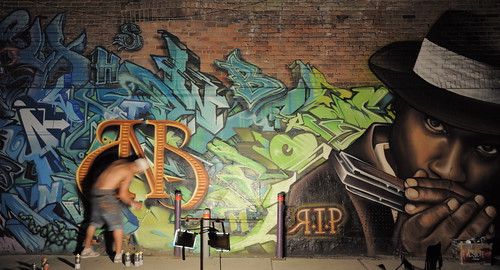
Recently, I have attended an interesting conference launching a new project under the branding
ST.ART. This aims to bring together street art forms and art education aimed to be used as a bridge to re-establish communication between young people and local community and to strengthen the sense of common ground and interest.
The specific objective of the ST.ART project is to help young people acquire the basic life-skills and competences necessary for their personal development, for future employment and for active European citizenship. The main aim of this project is to get to know the difference between aesthetic and street art forms, graffiti and vandalism, and how different choices can lead to different consequences.
The project aims at encouraging wider arts participation, creative teaching and learning through a new integrated methodology that combines Web 2.0 and Open Sim. This new kind of platforms integration creates a Virtual Learning Environment (VLE) that aims at developing an innovative learning environment in order to:
- - improve students’ transversal skills as digital, social and civic competences, sense of initiative and entrepreneurship, cultural awareness and expression;
- - encourage students’ creativity through developing street art works in Open Sim environment.
The performing arts are used to carry the message and spread information in exciting visual ways that capture the attention of users.
As MELISSA HUGHES states in her STREET ART & GRAFFITI ART: DEVELOPING AN UNDERSTANDING, “Enabling students to think critically for themselves is unquestionably integral to their development as young adults, and this type of critical thinking can take place inside the art classroom. The artistic process offers infinite opportunities for creative thought, personal expression, and problem solving. When students are deeply engaged in constructing meaning by looking at art, discussing, or constructing it, they grow artistically and personally.”
Through out the two-day conference one had the opportunity to meet foreign art teachers and share ideas. Very interesting sessions were organised having the intervention of foreign scholars about the subject. Workshop 3 turned out to be an exhaustive but informative featuring Street Art in relation to art history and its proceedings. Following are the number of lectures presented:
Art assessed over time
Chair: Ms. Monica Fasciani – University of the Studies Guglielmo Marconi
Overview of art works in Malta
Mr. James M. Grimaud - artist
The WAVES project: an experience of urban culture
Ms. Simona Galizia – Delegated to the Youth Policy by the Mayor of Civitavecchia -
coordinator project Waves
Street art or graffiti?
Mr. Cedar Lewisohn – artist, writer and curator
From street art to urban art
Mr. Dario Morgante – curator of Mondo Bizzarro Gallery in Rome
Being against.
Remarks on Rebellion and Recognition through the history of art
Ms. Irene Baldriga - teacher
ANISA Associazione Nazionale Italiana Insegnanti di Storia dell’Arte
 The Malta Institute of Professional Photography (MIPP) will inauguarate a photographic exhibition under the title ‘Streets of Malta’ on Friday, October 28, at Galleria Fiaf - Le Gru in Valverde(Sicily).
The Malta Institute of Professional Photography (MIPP) will inauguarate a photographic exhibition under the title ‘Streets of Malta’ on Friday, October 28, at Galleria Fiaf - Le Gru in Valverde(Sicily). 




